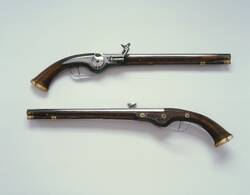This pair of wheel-lock pistols was used on 6 November 1632, in one of the bloodiest battles of the Thirty Years’ War.
That was the day on which the Protestant army, largely made up of Swedish troops, clashed with the Catholic Imperial forces under the command of Count Albrecht of Wallenstein. Thousands of men fell in the course of that day along a two-and-a-half kilometre front line. In the late afternoon, reinforcements arrived but Wallenstein decided not to send them into battle immediately. So the Swedish forces won the day, but they could hardely rejoice because the owner of this pair of wheel-lock pistols was among the fallen: That man was the Swedish king, Gustav Adolf. Riding at the head of his cavalry, he had led his forces into battle, but had been killed by the bullets of the Imperial army.
The Protestants‘ victory saved Saxony from being invaded by Catholic troops. Three years later, when he was negotiating the Peace of Prague, Elector Johann Georg I was able to come to a very satisfactory agreement with the Emperor. Oberlausitz and Niederlausitz were added to his territory.
The pistols were probably given to Johann Georg after the battle. They were made in Sweden around 1630, and their simple elegance is very striking. The barrel and lock are made of polished iron, and each pistol weighs about 850 grammes. The two gilded brass caps were added later. They are decorated with a portrait of the Swedish king wearing a laurel wreath.
On the front cover of the pocket Bible, which was printed in the Netherlands in 1631, there is an engraving of the coat of arms of King Gustav Adolf. The back cover bears the coat of arms of his wife, Maria Eleonora of Brandenburg, and the date 1632. It was a gift from the royal couple to the Swedish Field Marshal von Crailsheim. This memento was acquired for Dresden’s Grüne Gewölbe in the nineteenth century.
